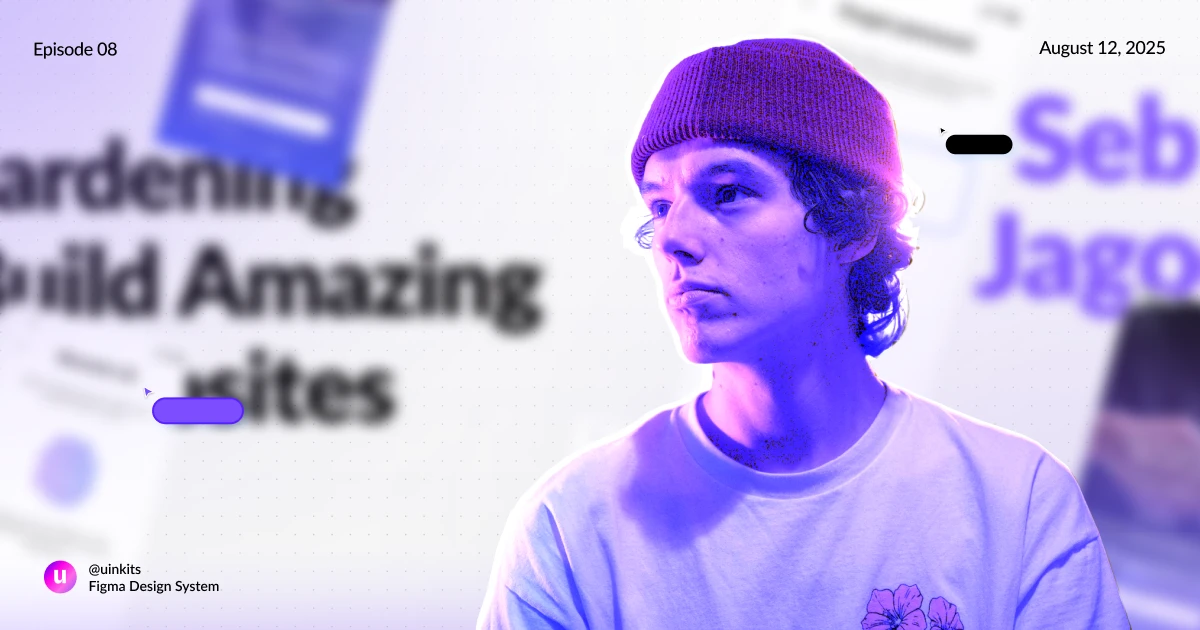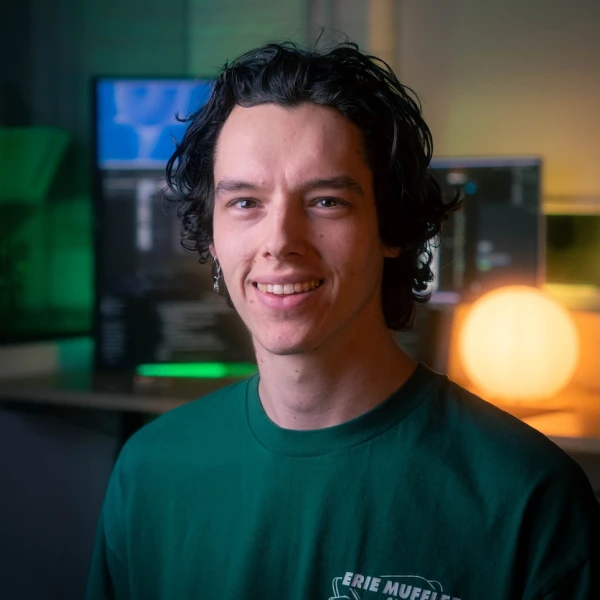


“Design isn’t art. Design often uses visuals to achieve a goal. But the aesthetic element isn’t the focus the way it often is with art.” – Seb Jagoe, Web Developer, Designer and Content Creator.
Have you ever looked at someone and just known for sure that they’re a creative person? Through their ideas, how they notice things, even their activities and hobbies. There’s a kind of curiosity and energy that runs through everything they do.
That’s Seb Jagoe.
He’s a web developer, designer, content creator, part-time regenerative farmer, and former DJ. But at his core? Seb is a creative.
Believe it or not, yes, it started with music, where he was a DJ and producer in his early twenties. Somewhere in between, he started watching free tutorials and courses to learn HTML and CSS. That’s when he realized something: he loved the process of creating something visual and functional, entirely from scratch.
Of course, this shouldn’t come as a surprise, as he “always loved creating”. But what started as a side activity “grew into a deeper passion”. Building websites became about “helping others tell their stories beautifully”, by focusing on their vision and on their purpose.
To Seb, a website is more than just a website. It’s about people.
As designers, we’ve always dealt with the ever-lasting debate between design and art. And to some extent, yes – we are artists. But the reality is that design is not art, and Seb emphasized this idea. A lot.
“Design isn't art.
Say it with me. Design isn’t art.”
For Seb, art exists for expression and emotion, with a focus on the aesthetic element. While he’s not trying to diminish the creativity that goes into creating a really beautiful website or app, he does point out that design is more than that.
So, if design isn’t art, what is it exactly? It’s communication. It’s strategy. It’s solving problems. And it’s guiding users toward a specific action, often without them even realizing it. This distinction matters because it changes how people and businesses approach a project, making it one of the most impactful decisions they can make.
Unfortunately, Seb admitted that many still treat a website (or even an app) like it’s a cost and don’t want to commit to the investment it actually requires. “Whenever I hear people ask ‘how much does a website cost’, I know they don’t understand”, he explained.
Of course, business owners don’t have to spend a fortune on a website, but a cheap website will deliver cheap results. Many companies, especially those at the beginning of the road, will hand the job to a relative or friend who knows a bit of coding, or throw together a quick template, just to say that they have a website.
The clients Seb loves working with – the ones running serious companies – understand the value of design and want to make this investment. Because at the end of the day, however, “a good design pays for itself by increasing engagement, conversions, and clarity”, he states.
Spending the right amount of money on a good design is a no-brainer if you want a solid business.
For Seb, that means creating a custom website. No template, no shortcuts, no nothing. Just a website that feels like it truly belongs to the brand it represents. Besides the obvious performance improvements, security, and aesthetics, going custom means every single detail is intentional and gives users a unique experience every time they interact with the brand.
“Every decision about colors, layout, animations, microcopy, etc, is made in service of that specific identity.”, Seb explains. And it’s the kind of thing a template could never replicate.
The result? A website that feels entirely personal, consistent, and, overall – memorable.
Building a website from scratch = more freedom. When there’s no limitation on how things “should” look or behave, we can explore, experiment, push boundaries, and even give up on certain playbook rules. For Seb, that’s why custom designs work perfectly!
This was exactly the case when he built a site for digital artist Mr Jackio, who is also a good friend of his. At first, Seb incorporated familiar elements. But each time, his client would take one look and say, “delete that”. After a lot of deletes, the website ended up breaking a lot of traditional design rules with unconventional layouts and unexpected interactions. Yet, it is perfectly aligned with the artist’s personality.
That’s the beauty of web design!
Creating such personalized websites requires a deep understanding of people. It’s the same instinct Seb leaned on when he grew his main Instagram audience from 0 to 100K in under eight months. That’s incredibly impressive! And our marketing manager right here will tell you that no, growth like that doesn’t happen by accident.
Seb is a master at this. He studied how and what people interacted with, what people responded to, and what caught their attention. So, he translated this research into both his designs and his content on social media.
“At the end of the day, it’s all the same. Social media, websites, music, art… They’re all just communication.”
How exactly do you do that? Well, Seb began the traditional way: looking at what everyone else was doing, watching the trends, and seeing which ideas seemed to work or not.
However, contrary to what most people would do, well, he did the opposite: instead of replicating these ideas, he thought, “Why would I hope to succeed doing what everyone else is doing?”. So, he started filming himself working on websites, edited the footage for hours, and paired it with an old beat he’d produced in his twenties.
When you think about it, it just seems like it’s an activity you’d do for fun – a passion project. But because it was so fun, it led to Seb creating a brand new account on January 1st, 2025, and started posting these videos that were soon to blow up and go viral in the first few weeks.
What’s funny is that both Seb’s web design career and his Instagram accounts started the same way: with him experimenting and what felt right to him.
At the core of it all, though, is communication – the foundation of everything. Behind every creative decision Seb makes, there’s a deep focus on how his content will connect with people. Often, that means stepping away from the screen altogether.
“Get offline. Seriously. Step away from Dribbble and Behance and ask: what else inspires you?”
It’s true! Real inspiration comes from the real world. Whether it’s nature, film, architecture, weird old books – anything that you’re passionate about. “Bring those influences into your design practice”, he says. Seb loves looking at buildings and noticing the shapes and the interplay of light and color. I personally remember spotting a weird color combination (that I never really thought of before) on an old storefront that inspired the entire palette for a project.
This is a lesson every designer should learn: take pictures, sketch whatever comes to mind, make mental notes of details beyond your office walls. Just like Emilie Mazurek’s story, inspiration comes from unexpected moments.
We’ve already established: design is communication. For Seb, every project starts with listening and understanding where they are coming from. This helps him align the website’s purpose with the brand’s vision and his ideas.
“What does success look like for this project? What’s the site for?”
The answers to these questions shape the entire approach. Next, Seb focuses on content and hierarchy – what needs to be said, and in what order. Through communication, he works closely with clients to express their message in the best way possible to make it clearer, more convincing, and, overall, more impactful.
Only then does it come down to the technical side: functionalities. “Web development is crazy. Things that seem simple can end up being really complicated.”, he admitted. That’s why he makes sure all features are listed well so that there’s no surprises.
What’s Seb’s step-by-step process that takes a blank canvas to a beautiful custom website?
These elements are the foundation for every design decision that follows. And it’s a blend of creativity and strategy that reflects Seb’s belief that design is, indeed, communication.
Remember the advice Seb gave? “Get offline”. Stepping away from the screen and finding inspiration is a practice he actually lives by.
For him, gardening is the way of staying connected to his roots (pun intended).
Not everyone knows it, but Seb is also a regenerative farmer and makes videos over at his farming brand, Solarity Acres. So, when asked if he could design a website for a plant or vegetable, he chose horsetail, as it’s one of the oldest plants on Earth. Why? Well, “they were the original trees way before any tree had entered the genetic lineage”, he stated.
The website would look minimalist but also futuristic, while also adding segmented scrubbing animations, earthy gradients, and even some kind of interactive timeline going back hundreds of millions of years. Sounds really cool, right?
Indeed, it seems a bit random. But when you look closer, the two worlds have a lot more in common than any of us could think of.
“Both are about systems, balance, intention”, Seb explains.
And he’s right! In gardening, we design with light, soil, water, and growth patterns in mind. You don’t just throw seeds around and hope for the best. In fact, “garden design is about understanding your goals, then taking stock of the resources you have available and using the fewest resources and the lightest touch to achieve those goals”.
Websites work in the same way. Every element – from the layout to the color palette to the tiniest microinteraction – affects the whole experience. And just like in gardening, the aim is to create something that thrives, using the simplest, most effective approach.
But do you know what else gardening and creating websites have in common? Both can be “wildly fulfilling when something finally blooms”.

